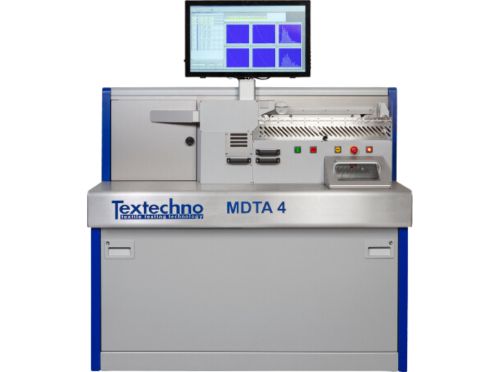The MDTA 4 processes raw cotton from the bale, tufts before carding, or card- and draw-frame slivers. It provides data relating to impurities – such as neps, seed-coat neps, trash, dust, and fibre fragment content. Finally, as an additional feature, the MDTA 4 can be used to determine the stickiness of raw cotton. The MDTA 4 can be combined with the NT-DA module for precise analysis of the number and size of impurities.
PT. Kawan Era Baru is the sole distributor in Indonesia for all Textechno’s products.

When applied to man-made fibres (e.g. polyester staple fibres, PSF), MDTA 4 can be used to sort out impurities such as fused fibres and other imperfections.
Based on the well-proved MDTA 3 model, MDTA 4 now offers in addition a measurement of the length of individual fibres floating in an air stream.
By processing the cleaned ring-shaped fibre strand provided by the MDTA 4, an OE yarn for further analysis can be produced, e.g. for the measurement of evenness, hairiness, tensile strength, and elongation. When using a blend with chemical fibres instead of pure cotton, even blended yarns can be spun on laboratory scale.
During opening of the input fibres, the energy required to open the sample to single fibres is recorded to determine the opening behavior. This opening work is an essential parameter for the carding process – depending on the setting of the MDTA 4 it is indicative of the fibre-to-fibre or the fibre-to-metal friction.
Impurity Testing
One of the most important quality concerns of a spinning mill is the purity grade of the raw material. Textechno´s latest version of the Micro-Dust and Trash Analyser, the MDTA 4, cleans the raw cotton from any impurity and precisely analyses the dust content, fibre fragments, short fibres, neps, seed-coat neps and trash particles.
Dust and fibre fragments are collected in appropriate filters. Neps, seed-coat neps and trash particles are separated into a dedicated chamber to be weighted using a high-precision balance. From this weight the nonlint percentage is determined. By using an additional NT-DA (Neps and Trash-Digital Analysis) or OPTOTEST, these impurities are classified according to their size and number as neps, seedcoat neps and trash particles.
Hence, the MDTA 4 is the first and only testing instrument to combine both test methods – the weight percentage and number of impurities per gram. The MDTA 4 allows to test different sample forms, such as fibres from the bale, tufts before carding as well as carding- and draw-frame slivers. The instrument can be used to analyse the cleaning efficiency of the back process and carding machines.
During the measurement, a sample of up to 10 g is mechanically opened down to single fibres by a roller. Both, cotton and man-made fibres are tested by the MDTA 4.
Opening Work Measurement
During opening, the energy required to open the sample to single fibres is recorded to determine the opening behavior. This opening work is an essential parameter for the carding process – depending on the setting of the MDTA 4 it is indicative of the fibre-to-fibre or the fibre-to-metal friction.
Sliver Creation and Spinnability
After opening, the clean fibres are collected in a rotor ring assembly to create a sliver of 1 m length which is useful for various applications: e.g. counting number of sticky points or checking the cleanability and nep sensitivity of the fibres. Since the fibres are well blended in the sliver created by MDTA 4, the color of a mélange is quickly evaluated. Finally, spinning the sliver into an OE yarn allows to directly assess the spinnablity of the fibres.
Fibre Length Measurement
Alternatively, the clean fibres can be passed through an opto-electronic sensor assembly after opening. Here, the length of the individual fibres is measured using digital image processing. This length measurement assures not only an accurate measurement of the fibre length distribution, but also a precise determination of the short fibre content in absolute numbers.
- Mains supply: 230 V, 50 (60) Hz
- Compressed air: 6 bar
- Capacity: Approx. 100 l/min
- Lacquer finish: RAL 9006/5002
- Height: 1250 mm
- Width: 1250 mm
- Depth: 900 mm
- Weight: approx. 270 kg
The above technical contents can be subject to changes by Textechno.
